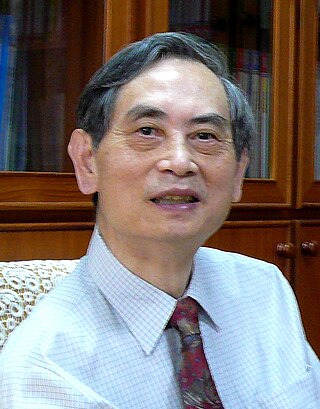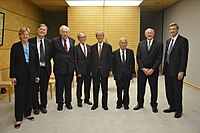Noemie Benczer Koller is a nuclear physicist. She was the first tenured female professor of Rutgers College.
Tom C. Lubensky is an American physicist. He is currently the Christopher H. Browne Distinguished Professor at the University of Pennsylvania, where he was Mary Amanda Wood professor of physics (1998–2009) and chair of the Department of Physics and Astronomy.
The National Commission on the BP Deepwater Horizon Oil Spill and Offshore Drilling is a bipartisan presidential commission, established by Executive Order 13543 signed by Barack Obama on May 21, 2010, that is "tasked with providing recommendations on how the United States can prevent and mitigate the impact of any future spills that result from offshore drilling." It came about as a result of the April 2010 Deepwater Horizon oil spill. The first public hearings, held on July 12 and 13, 2010 in New Orleans, included scheduled testimony from Federal government officials and representatives of BP on the status of the spill and clean-up efforts, as well as from local officials, community leaders, and scientists on the economic, cultural and ecological impacts of the oil spill on Gulf Coast communities and ecosystems.

Sow-Hsin Chen, was a Hoklo Taiwanese physicist and Professor Emeritus at Massachusetts Institute of Technology (MIT). He was a recognized pioneer in the research of the dynamic properties of supercooled and interfacial water with the use of neutron scattering techniques. As an educator, he was recognized for his training of young scientists in the use of those same techniques. Regarding hydrogen storage, his research focused on the use of activated carbon to allow hydrogen to be stored at room temperature.

John M. "Jack" Carpenter was an American nuclear engineer known as the originator of the technique for utilizing accelerator-induced intense pulses of neutrons for research and developing the first spallation slow neutron source based on a proton synchrotron, the Intense Pulsed Neutron Source (IPNS). He died on 10 March 2020.

Susan K. Avery is an American atmospheric physicist and President Emerita of the Woods Hole Oceanographic Institution (WHOI) in Massachusetts, where she led the marine science and engineering research organization from 2008–2015. She was the ninth president and director and the first woman to hold the leadership role at WHOI. She is Professor Emerita at the University of Colorado, Boulder (UCB), where she served on the faculty from 1982–2008. While at UCB she also served in various administrative positions, including director of the Cooperative Institute for Research in Environmental Sciences (CIRES), a 550-member collaborative institute between UCB and the National Oceanic and Atmospheric Administration (NOAA) (1994-2004); and interim positions (2004-2007) as vice chancellor for research and dean of the graduate school, and provost and executive vice chancellor for academic affairs. Currently she is a senior fellow at the Consortium for Ocean Leadership in Washington, D.C.

Brent Fultz is an American physicist and materials scientist and one of the world's leading authorities on statistical mechanics, diffraction, and phase transitions in materials. Fultz is the Barbara and Stanley Rawn Jr. Professor of Applied Physics and Materials Science at the California Institute of Technology. He is known for his research in materials physics and materials chemistry, and for establishing the importance of phonon entropy to the phase stability of materials. Additionally, Fultz oversaw the construction of the wide angular-range chopper spectrometer (ARCS) instrument at the Spallation Neutron Source and has made advances in phonon measuring techniques.
Igor Mezić is a mechanical engineer, mathematician, and Distinguished Professor of mechanical engineering and mathematics at the University of California, Santa Barbara. He is best known for his contributions to operator theoretic, data driven approach to dynamical systems theory that he advanced via articles based on Koopman operator theory, and his work on theory of mixing, that culminated in work on microfluidic mixer design, and mapping oil refuse from the Deepwater Horizon oil spill in the Gulf of Mexico to aid in cleaning efforts.
Nadya Mason is the dean of the Pritzker School of Molecular Engineering at the University of Chicago, since October 2023. Prior to joining the University of Chicago, she was the Rosalyn Sussman Yalow Professor of Physics at the University of Illinois at Urbana-Champaign. As a condensed matter experimentalist, she works on the quantum limits of low-dimensional systems. Mason was the Director of the Illinois Materials Research Science and Engineering Center (I-MRSEC) and, from September 2022 through September 2023, the Director of the Beckman Institute for Advanced Science and Technology. She was the first woman and woman of color to work as the director at the institute. In 2021, she was elected to the National Academy of Sciences.

Samantha "Mandy" Joye is an American oceanographer who is well known for her work studying the Deepwater Horizon Oil Spill. She is a professor at the University of Georgia in the Department of Marine Sciences. Joye has made fundamental contributions in ocean biogeochemistry and microbial ecology, and is also regularly called upon by scientific and policy agencies as well as the media for expert commentary on ocean ecology. She was the expedition scientist and a lead science advisor for The Deep episode, part of the BBC's Blue Planet II, and is featured in production videos including Brine Pools: Exploring an Alien World for Blue Planet II and Future of the Oceans. She led the “Ecosystem Impacts of Oil and Gas in the Gulf” research consortium between 2014 and 2020 and conducts research to understand relationships between biogeochemical cycles, microbial activity, and environmental factors in many diverse ocean environments.
Bonny Laura Schumaker is an American physicist and pilot who worked on the LISA Pathfinder. In 2010 she founded the nonprofit "On Wings of Care", a charity which protects animals and environments.
Félicie Albert is a French-born American physicist working on laser plasma accelerators. She is the deputy director for the Center for High Energy Density Science at Lawrence Livermore National Laboratory and staff scientist at the National Ignition Facility and Photon Science Directorate and the Joint High Energy Density Sciences organization. She received BS in 2003 in engineering from Ecole Nationale Supérieure de Physique de Marseille, in France, her master's degree in optics from the University of Central Florida in 2004 and her PhD from Ecole Polytechnique in 2007, before joining LLNL as a postdoctoral fellow in 2008. Her main expertise are "the generation and applications of novel sources of electrons, X-rays and gamma-rays through laser-plasma interaction, laser-wakefield acceleration and Compton scattering."
Natalie Ann Roe is an experimental particle physicist and observational cosmologist, and the Associate Laboratory Director for the Physical Sciences Area at Lawrence Berkeley National Laboratory (LBNL) since 2020. Previously, she was the Physics Division Director for eight years. She has been awarded as the Fellow of American Physical Society (APS) and American Association for the Advancement of Science (AAAS) for her exceptional scientific career and contributions.
Susanne F. Yelin is a German physicist specializing in theoretical quantum optics and known for her work in quantum coherence and superradiance. She is a professor of physics at the University of Connecticut, a professor of physics in residence at Harvard University, and vice director of the Max Planck/Harvard Research Center for Quantum Optics.
Karen Irene Winey is an American materials scientist and chair of the University of Pennsylvania department of materials science and engineering.
Kendra Lee Daly is an oceanographer known for her work on zooplankton, particularly in low oxygen regions of the ocean. She is a professor at the University of South Florida, and an elected fellow of the American Association for the Advancement of Science.
Ali Yazdani is an American physicist who focuses on understanding new quantum phases of matter. He is currently the Class of 1909 Professor of Physics at Princeton University and the Director of the Princeton Center for Complex Materials, a material research science and technology (MRSEC) center supported by the National Science Foundation. Together with Seamus Davis, he is the recipient of the 2023 Buckley Prize from the American Physical Society.
Beverly Karplus Hartline is an American physicist, science communicator, and academic administrator, known for her research in physics outreach to the general public and for the promotion of women in physics and the sciences. She is a former deputy director of the Argonne National Laboratory, and professor emerita of geological engineering at Montana Technological University, where she was vice-chancellor for research and dean of the graduate school before retiring.
Jacinta Carmel Conrad is an American soft matter physicist. She is the Frank M. Tiller Professor of Chemical and Biomolecular Engineering at the University of Houston. Conrad was elected a fellow of the American Physical Society in 2022 for "experimental contributions to understanding nanoparticle dynamics, bacterial adhesion, and colloid-polymer mixtures, using advanced microscopy and light scattering techniques."

Andrea Lynn "Annie" Kritcher is an American nuclear engineer and physicist who works at the Lawrence Livermore National Laboratory. She was responsible for the development of Hybrid-E, a capsule that enables inertial confinement fusion. She was elected Fellow of the American Physical Society in 2022.







